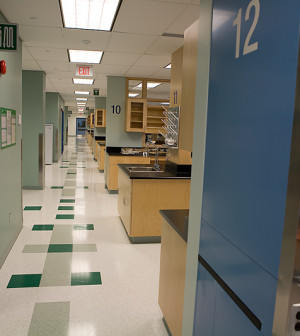- Strengthening Your Relationship: Practical Strategies
- Skip Storing This Everyday Product in the Fridge Door
- Green Tea + B3 Pairing May Boost Brain Health
- Navigating Your Midlife Crisis: Embracing New Possibilities
- City Raccoons Showing Signs of Domestication
- Mapping the Exposome: Science Broadens Focus to Environmental Disease Triggers
- One Week Less on Social Media Linked to Better Mental Health
- Your Brain Changes in Stages as You Age, Study Finds
- Some Suicide Victims Show No Typical Warning Signs, Study Finds
- ByHeart Formula Faces Lawsuits After Babies Sickened With Botulism
Frequent Mammograms Tied to Lower Risk of Breast Cancer Spread


Breast cancer patients who have mammograms every 12 to 18 months have less chance of lymph node involvement than those who wait longer, therefore improving their outlook, according to an early new study.
As breast cancer progresses, cancer cells may spread to the lymph nodes and other parts of the body, requiring more extensive treatment.
“We found doing mammograms at intervals longer than one and a half years essentially does affect patient prognosis,” said study researcher Dr. Lilian Wang. “In our study, those patients were found to have a significantly greater lymph node positivity.”
From 2007 to 2010, Wang evaluated more than 300 women, all of whom were diagnosed with breast cancer found during a routine mammogram. She divided them into three groups, based on the interval between mammograms: less than one and a half years, one and a half to three years or more than three years. Most women were in the first category.
Wang looked to see how many women had cancer that had spread to their lymph nodes. Although nearly 9 percent of those in the shortest interval had lymph node involvement, 21 percent of those in the middle group and more than 15 percent in the longest-interval group did.
The stage at which the cancer was diagnosed did not differ among the groups, she found.
Although the study found an association between more frequent screenings and less lymph node involvement among breast cancer patients, it did not establish a cause-and-effect relationship.
Wang, an assistant professor of radiology at Northwestern University’s Feinberg School of Medicine, is scheduled to present the findings Wednesday at the annual meeting of the Radiological Society of North America, in Chicago.
The best interval between routine mammograms has been a point of discussion and debate for years.
In 2009, the U.S. Preventive Services Task Force, an independent group of experts, changed their recommendations, which previously advised annual mammograms. The updated recommendations advised that women begin routine mammograms at age 50, and that every two years was an acceptable interval. Women aged 40 to 50 were advised to discuss the pros and cons of screening with their doctors.
The updated guidelines took into account death from breast cancer with different screening intervals and the downsides of false positives, which could translate into more testing, expense and anxiety.
Other organizations, however, including the American Cancer Society and the American College of Radiology, continue to recommend annual mammograms for women beginning at age 40.
The new results, Wang said, support the recommendations for annual testing beginning at age 40 for average-risk women.
The study disclosed that another co-author has served on boards or been a speaker for imaging-device manufacturers.
An expert not connected with the new study said its focus — looking not at the risk of death from breast cancer, but the chances of cancer spreading to the lymph nodes — is a legitimate one.
“If you catch someone with early stage cancer, they are going to need less extensive surgery, and maybe no chemo,” said Dr. Laura Kruper, director of the Cooper-Finkel Women’s Health Center at the City of Hope Cancer Center, in Duarte, Calif.
“[The new study] adds more power behind the fact that we do need screening mammograms starting at age 40 and every year,” she said.
In a second study presented at the meeting, other researchers reported on a new technique that uses focused ultrasound under the MRI guidance to heat and destroy breast cancer tissue.
Researchers at Sapienza University, in Rome, evaluated the treatment in 12 breast cancer patients before surgical removal of their cancer and biopsy of their lymph nodes.
When the researchers looked at the tissue, no sign of tumor was found in 10 of the 12 patients. More research is needed, however, before the technique could be considered as a standalone treatment, the researchers said.
Kruper agreed. The new technique is far from being ready for clinical use, she said. Among the unanswered questions are how the results will stand up over time.
Because both studies were presented at a medical meeting, the data and conclusions should be viewed as preliminary until published in a peer-reviewed journal.
More information
To learn more about mammograms, visit the American Cancer Society.
Source: HealthDay
Copyright © 2025 HealthDay. All rights reserved.










